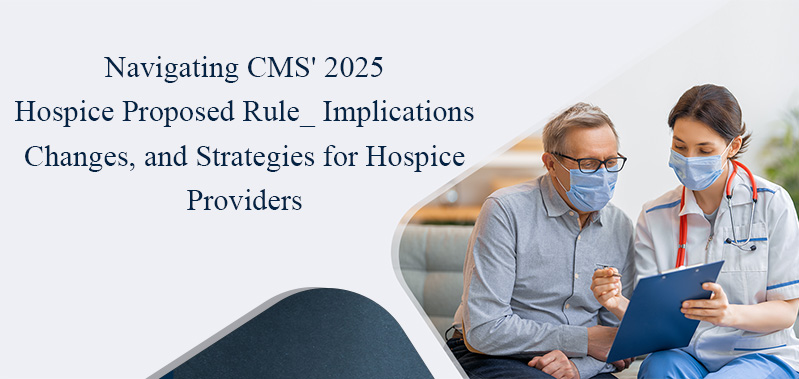
Navigating CMS 2025 Hospice Proposed Rule: Implications, Changes, and Strategies for Hospice Providers
As the healthcare field keeps changing, hospice providers need to plan carefully to handle new rules and make their operations more efficient. The recent announcement from the U.S. Centers for Medicare & Medicaid Services (CMS) about how they'll pay hospices in 2025 brings both challenges and chances for these organizations. To keep giving great care to patients, it's crucial for hospices to understand what this announcement means and to plan ahead by attending Hospice webinars.
The CMS's plan for how they'll pay hospices in 2025 is a big deal because it changes how much money hospices get and what rules they have to follow. CMS is suggesting a 2.6% increase in hospice payments for the fiscal year (FY) 2025, which would amount to roughly $705 million more compared to this year. The proposed rule (CM-1810-P) explains that this increase stems from a 3.0% rise in the market basket percentage, adjusted down by 0.4 percentage points for productivity. However, hospices failing to provide required quality data would face a penalty, resulting in a -1.4% adjustment.
Furthermore, CMS is proposing a hospice payment cap of $34,364.85 for FY 2025. This cap sets a limit on total Medicare payments per patient per year and would represent a 2.6% increase from the FY 2024 rate of $33,494.01 if it remains unchanged.
The proposed rule also includes adopting the latest statistical area outlines according to the Office of Management and Budget (OMB). This policy would modify current core-based statistical areas, impacting the geographic wage index for Medicare payments.
Hospices affected by the changes to their geographic wage index due to this policy would have the option to request a 5% cap on any decrease compared to the previous year's wage index. This cap, implemented in FY 2023, aims to prevent a geographic area's wage index from dropping below 95% of its previous value, as clarified by CMS in the proposed rule.
The latest Hospice webinars give information about the proposed payment rule which addresses Hospice Conditions of Participation (CoPs), with CMS seeking to update language discrepancies regarding medical director and physician designee CoPs, as well as the inclusion of a physician member in the interdisciplinary group (IDG) in the payment requirements for certifying terminal illness and admitting patients to hospice care. Regulatory text adjustments would also aim to clarify requirements related to the election statement and Notice of Election (NOE) in the CoPs, providing clearer distinctions between the two sets of requirements.
This rule suggests adopting and using the HOPE patient-level data collection tool starting in FY 2025. It will essentially replace the existing Hospice Item Set (HIS) structure once it's in place. Unlike HIS, which only collects data when a patient enters and leaves hospice care, HOPE will gather information at various points during a patient's hospice stay, including admission, the HOPE Update Visit (HUV), and discharge. This broader data collection will help CMS gather more detailed patient information throughout their time in hospice care to support quality measures. HOPE covers several new or expanded domains compared to HIS, such as sociodemographic information, expanded diagnoses, assessing symptom impact, and imminent death.
In addition, this proposed rule seeks feedback from stakeholders on potential data collection items related to four Social Determinants of Health (SDOHs): housing instability, food insecurity, and challenges related to utilities and transportation. These items may be relevant to hospice care, and input is requested on how they might be adapted to better suit the hospice setting.
Finally, this proposed rule suggests changes to the Hospice CAHPS( Consumer Assessment of Healthcare Providers and Systems) Survey based on findings from a mode experiment conducted in 2021. The proposed changes include:
- Adding a web-mail mode, where respondents receive an email inviting them to complete a web survey, with a follow-up mailed survey for those who don't respond.
- Shortening and simplifying the survey. Modifying survey administration protocols to include a prenotification letter and extending the survey period.
- Introducing a new, two-item Care Preferences measure.
- Revising existing measures like Hospice Team Communication and Getting Hospice Care Training.
- Removing three nursing home items and other survey items affected by proposed changes in this rule.
- The Hospice Special Focus Program (SFP) uses data from four CAHPS Hospice Survey measures related to caregiver experience. This proposed rule includes non-substantive changes to the Overall Rating of this Hospice measure that won't affect the SFP algorithm.
Conclusion:
It's important for hospices to plan ahead for the changes in how they're paid in 2025 by CMS. By understanding the changes, making a plan, and working together, hospices can keep giving great care to those who need it. Collaboration, innovation, and a commitment to excellence will be key in facing these challenges and continuing to provide compassionate care to patients and families. Hospice webinars are ready to support hospices through these changes and help them succeed. Contact us today to learn more about how we can help.





Would like to attend your webinar on this topic. Kindly update when you will conduct a webinar.